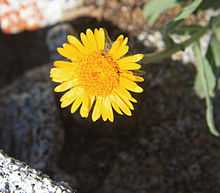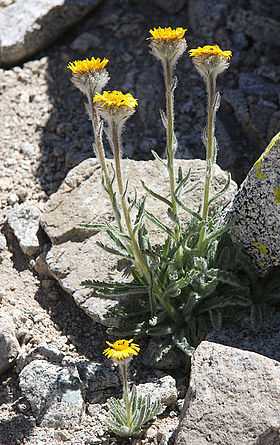Hulsea algida
| Hulsea algida | |
|---|---|
 | |
| Scientific classification | |
| Kingdom: | Plantae |
| (unranked): | Angiosperms |
| (unranked): | Eudicots |
| (unranked): | Asterids |
| Order: | Asterales |
| Family: | Asteraceae |
| Genus: | Hulsea |
| Species: | H. algida |
| Binomial name | |
| Hulsea algida Gray | |
| Synonyms | |
|
Hulsea caespitosa | |
Hulsea algida is a species of flowering plant in the daisy family, known by the common name Pacific hulsea or alpine gold.
It is native to California (Sierra Nevada, White Mountains) and the Northwestern United States. It grows between 9,500 and 14,000 feet (2,900 and 4,300 m) in elevation, in alpine and subalpine talus habitats.[1]
Description

Hulsea algida is a hairy, glandular perennial herb producing stout erect stems approaching 40 centimeters in maximum height. The dark green leaves are narrow and covered in white hairs, and the edges are wavy and toothed. Most of the leaves occur in a thick patch at the base of the plant and some grow from the stems.
The flower head is encased in a cup of densely woolly reddish green phyllaries which open to reveal a daisylike bloom one to three centimeters across. The center of the head is filled with yellow or orange disc florets and the circumference has up to 60 bright yellow or gold ray florets each about a centimeter long with rounded or toothed tips.
The fruit is an achene up to a centimeter long with a pappus which may be longer.
See also
References
- ↑ Calflora database: Hulsea algida . accessed 2.2.2013
External links
| Wikimedia Commons has media related to Hulsea algida. |
- Jepson Manual Treatment — Hulsea algida
- USDA Plants Profile: Hulsea algida (alpine gold)
- Hulsea algida — U.C. Photo gallery